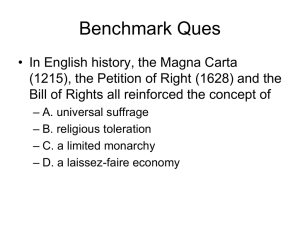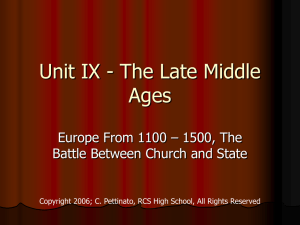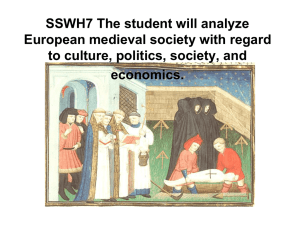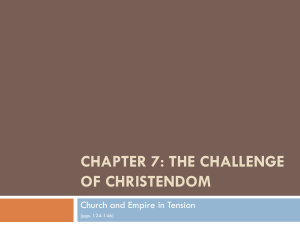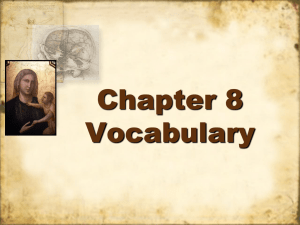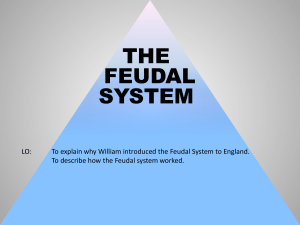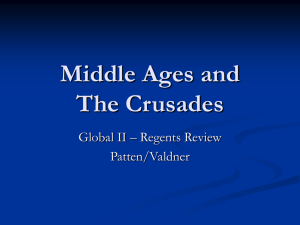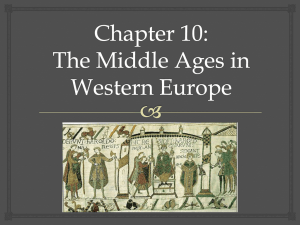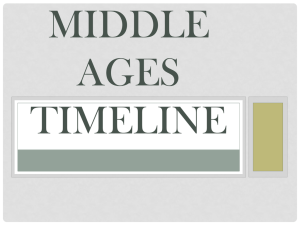World History Ch 12 - mrdarbyshistory.org
advertisement
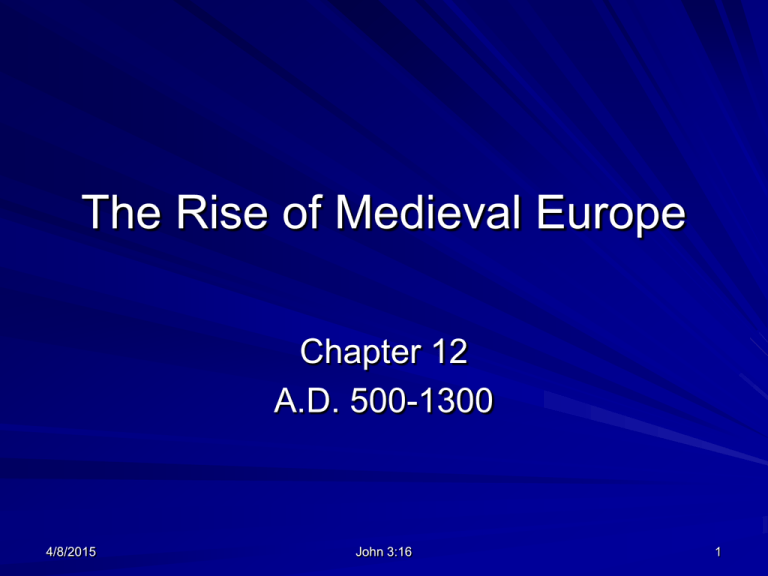
The Rise of Medieval Europe Chapter 12 A.D. 500-1300 4/8/2015 John 3:16 1 Middle Ages Sometimes referred to a the “Dark Ages” Transition between ancient and modern times Roman urban world of was destroyed Life was in the villages 4/8/2015 John 3:16 2 Chapter Themes Movement: invasions by Vikings, Magyars, and Muslims influence medieval Europe Cooperation: Nobles, church officials and peasants develop ties of loyalty and service to one another 4/8/2015 John 3:16 3 Chapter Themes Uniformity: The Catholic Church affects every aspect of medieval life Conflict: European kings, feudal lords, and popes struggle for political dominance 4/8/2015 John 3:16 4 Frankish Rulers Main Idea: Frankish rulers, like Charlemagne, were exceptional rulers for their time Terms to define: mayor of palace, count People to Meet: Clovis, Charles Martel, Pepin the Short, Charlemagne, the Vikings Places to locate: Frankish Empire, Scandinavia 4/8/2015 John 3:16 5 Early Frank Rulers--Merovingian Rulers A.D. 400s Settled now France and Western Germany Franks emerged as strongest Germanic tribe Earlier rulers, Merovingian (MEHR*uh*VIHN*jee*uhn) rulers, held power until the early 700s – Clovis, Charles Martel, Pepin the Short 4/8/2015 John 3:16 6 Clovis King of the Franks First Germanic ruler to accept Catholicism Military victories and religious conversion gave him stability 4/8/2015 John 3:16 7 Clovis For generations, kings had passed their kingdoms to their heirs This turned out to be unsuccessful due to family infighting New system was Mayors of the Palace 4/8/2015 John 3:16 8 Mayors of the Palace Political power had passed from kings to mayors of the palace Previously, the kingdom was divided among the king’s heirs 4/8/2015 John 3:16 9 Charles Martel A.D. 714, Charles Martel became mayor of the palace When Muslim forces threatened Europe in A.D. 732, Charles (the Hammer) led the successful defense of Tours, in France 4/8/2015 John 3:16 10 Charles Martel Tours victory won him great prestige Ensured Christianity would remain the dominate religion in Europe 4/8/2015 John 3:16 11 Pepin the Short Charles Martel’s son A.D. 752, became king of the Franks The pope anointed (put holy oil) him making him a divinely appointed ruler in eyes of people 4/8/2015 John 3:16 12 Pepin the Short Pepin expected to help pope against enemies Pepin forced Lombards (Germanic people) to leave Rome 4/8/2015 John 3:16 13 Pippin the Short Gave pope large strip of Lombard land in Italy Pope cut Byzantine ties Fortunes of western Europe and Catholicism more closely tied together 4/8/2015 John 3:16 14 Charlemagne’s Empire Pepin’s son-Charlemagne A.D. 768, became Frankish king Pictured: Pepin and Charlemagne 4/8/2015 John 3:16 15 Charlemagne’s Empire Known as Charlemagne or Charles the Great One of Europe’s great monarchs 4/8/2015 John 3:16 16 Charlemagne’s Empire In Latin, his name is written “Carolus Magnus” Gave the name of Carolingian to his dynasty 4/8/2015 John 3:16 17 Charlemagne’s Empire Nearly doubled the size of his borders – Germany, France, northern Spain, and most of Italy Became known as the Frankish Empire Pictured: Charlemagne’s coronation 4/8/2015 John 3:16 18 Charlemagne Empire Seeking to revive learning, he established a palace school at Aachen School helped provide western Europeans with a common set of ideas 4/8/2015 John 3:16 19 Charlemagne (cont) Studies based on the Bible and Latin Scholars preserved classical learning by copying ancient manuscripts – Ancient manuscripts – Roman classics 4/8/2015 John 3:16 20 A Christian Realm Western Europeans wanted the creation of a Christian Roman Empire Church leaders believed Charlemagne could create it A.D. 800 he came to Rome to defend the pope against the Roman nobles In gratitude, the pope crowned him the new Roman Emperor 4/8/2015 John 3:16 21 A Christian Realm Charlemagne wanted the title but had misgivings accepting the crown from the pope—were church officials superior to rulers? Charlemagne accepted his duties as emperor Worked to strengthen empire 4/8/2015 John 3:16 22 A Christian Realm He relied on local officials called counts to assist him. – They raised armies, solved local problems, stopped feuds, protected the weak, etc Charlemagne traveled Europe to observe 4/8/2015 John 3:16 23 Collapse of Charlemagne’s Empire His forceful personality helped hold empire together A.D. 814, his family could not hold the empire together; in A.D. 843 Charlemagne’s three grandsons agreed to divide the empire’s lands 4/8/2015 John 3:16 24 Collapse of Charlemagne’s Empire (cont) Treaty of Verdun divided Carolingian lands – Charles the Bald: France – Louis the German: Germany – Lothair became the Roman emperor and took stretch of land from the North Sea southward to Italy 4/8/2015 John 3:16 25 Invasions Increase Disunity Muslims from North Africa Slavs from the East Magyars from Asia The most threatening attacks came from the Vikings, raiders from Scandinavia from the north 4/8/2015 John 3:16 26 Viking Invasions To go “a-viking” means to fight as a warrior Explorers skilled in sailing, trading, and fighting who settled throughout Europe Ships – Light for carrying over land for quick attacks – Shallow for navigating rivers – Sturdy for ocean-going 4/8/2015 John 3:16 27 Viking Invasions (cont) A.D. 800 sought riches Left homeland which was overcrowded Departed lands are now Norway, Denmark, and Sweden 4/8/2015 John 3:16 28 Viking Trade Moved along Atlantic and Mediterranean coasts of Europe Settle the North Atlantic islands of Greenland and Iceland and reached North America Temporarily held England Settled in present-day Ukraine and Russia 4/8/2015 John 3:16 29 Viking Culture Worshipped many deities Stories of gods flourished called “Eddas” Accepted Christianity by A.D. 1100 – Began to write their letters using Roman letters 4/8/2015 John 3:16 30 A New Europe People of Europe suffer at the hands of Vikings and others Raids isolated people and weakened central authority Economic collapse—lack of trade, etc Decline of monarchies resulted in nobles and local officials taking over defense A.D. 900s, new political and social system brought more stability 4/8/2015 John 3:16 31 Medieval Life Section 2 4/8/2015 John 3:16 32 Main Idea Loyalties were maintained even in a divided and often violent Europe 4/8/2015 John 3:16 33 Terms to Know Feudalism Fief Vassal Homage Tournament Chivalry Manorialism Serf 4/8/2015 John 3:16 34 People to Meet Knights Lords Ladies Peasants 4/8/2015 John 3:16 35 Overview of Feudalism Weakened central government/power Feudalism developed in western Europe Stressed alliances between monarchs and nobles Land is given to nobles in exchange for loyalty Peasants came with the land to farm it 4/8/2015 John 3:16 36 Feudalism Relationships The tie between military service and land ownership began in A.D. 700s 4/8/2015 John 3:16 37 Feudalism Relationships Charles Martel fighting Muslims who fought using cavalry with stirrups/saddles – Martel granted fiefs— estates with peasants—for income to buy horses and equipment 4/8/2015 John 3:16 38 Feudalism Relationships (cont) Frankish kings later enlarged this system by giving fiefs to counts and local officials – These nobles assumed many government powers and swore loyalty to the king 4/8/2015 John 3:16 39 Feudalism Relationships By A.D. 900s, such arrangements among nobles and monarchs emerged as feudalism – Lords were permitted to pass their lands on to heirs in return for providing knights for the royal army 4/8/2015 John 3:16 40 Feudalism Relationships (cont) Like a pyramid with king on top, lords in the middle, and knights on bottom – Lords served another lord of the next higher rank – Lords could also serve as vassals—a noble pledging loyalty to more than one lord – Conflicts could arrive if a vassal served two lords at war with each other 4/8/2015 John 3:16 41 Feudal Obligations Ties between lord and vassal made official in a solemn ceremony known as “homage” In return for a fief, vassals pledged to perform certain duties, the most important was military service – Knights usually provided for 40-60 days/year – Provided food and lodging for lord on visits – Paid ransom if lord caught in battle 4/8/2015 John 3:16 42 Castles for Defense Because of lack of strong central government, warfare occurred frequently in feudal society – Therefore, every nobleman built a castle for security By A.D. 1100s castle were built of stone with thick walls and turrets—small towers 4/8/2015 John 3:16 43 Castle for Defense Each castle was built on a hill or mound surrounded by a deep moat 4/8/2015 John 3:16 44 Castles for Defense Castle had a square tower called a “keep” – Contained many rooms Hall Dungeon – Surrounding the keep was a “bailey” Buildings—barracks, storerooms, workshops and chapel 4/8/2015 John 3:16 45 Castle for Defense Castles were built for security and were cold, dingy, and dark places 4/8/2015 John 3:16 46 Life of the Nobility Lords, ladies, and knights made up the nobility of the middle ages 4/8/2015 John 3:16 47 Life of Nobility Within his fief, a lord had almost total authority, collecting rents in goods from peasants and settling disputes between vassals 4/8/2015 John 3:16 48 Life of Nobility Attempts to seize the fief were met with violent resistance 4/8/2015 John 3:16 49 Life of Nobility (cont) In contrast, a lady, or noblewoman, had few rights – Her primary duties lay in bringing up children and taking care of the household 4/8/2015 John 3:16 50 Life of Nobility Could be married as early as twelve to a man selected by her father Took pride in needlework, turning out cloth, and fine embroidery 4/8/2015 John 3:16 51 Life of the Nobility Women made effective medicines from plants and herbs Some shared the supervision of the castle for husbands off to war 4/8/2015 John 3:16 52 Entertainment Tournaments, mock battles Knights chose lady to fight for – Usually married to gentleman of higher status 4/8/2015 John 3:16 53 Entertainment Tournaments could be dangerous Church looked down on them Large group of armed men in one place Winning ladies hearts was large part of it 4/8/2015 John 3:16 54 Entertainment Hunting – Both men and women learned falconry and archery 4/8/2015 John 3:16 55 Entertainment Dinner featured several dishes of game and fish Minstrels, or singers, might follow 4/8/2015 John 3:16 56 Becoming a Knight Nobleman’s son begins training for knighthood at age of seven 4/8/2015 John 3:16 57 Becoming a Knight Starts as a page, assistant to a lord At 15, he becomes a squire who assists knights and studies weapon and battle Once proven in battle, he is knighted 4/8/2015 John 3:16 58 Becoming a Knight Behavior of knight governed by code of chivalry – – – – – 4/8/2015 Brave in battle Fight fairly Keep promises Defend the church Treat women with noble birth in a courteous manner John 3:16 59 Becoming a Knight Chivalry became basis of good manners in Western society 4/8/2015 John 3:16 60 The Manorial System The wealth of a feudal lord came from the labor of the peasants who lived on and worked the lord’s land – Since the Romans, peasants had worked for large land owners 4/8/2015 John 3:16 61 Manorialism vs Feudalism Manorialism: Economic Economic system Originated fro latifundia Lords owned land Serfs controlled land Property was shared Lords headed manors Lords protected people 4/8/2015 Feudalism: Political Political System Mutual obligations Fiefs awarded to vassals Lords minted coins and made laws Lords headed manors Loyalty Pyramid structure John 3:16 62 The Manorial System By the Middle Ages, economic life across Europe centered around a system of agricultural production called “manorialism” – Provided peasants with food, shelter, and protection 4/8/2015 John 3:16 63 The Manorial System Sizes of estates varied from several hundred to several thousand acres – Included lord’s house, pastures, crop fields, forests, and peasant village Manorialism concerns economic ties between nobles and peasants 4/8/2015 John 3:16 64 Work on a Manor In return for the lord’s protection, peasants provided various services to the lord – Farming the land – Payments for goods, e.g. when a peasant ground grain, a portion was left to the lord – Road and bridge repair Warfare made trade near impossible so manors had to produce what was needed 4/8/2015 John 3:16 65 Work on a Manor Most peasants farmed or herded sheep Some were artisans like blacksmiths, carpenters, millers (grain grounding), shoemakers, brewers, etc. Black cotton dress 4/8/2015 John 3:16 66 Work on a Manor Most peasants were “serfs”—could not leave the manor without permission – Serfs were not slaves and could not be sold Cruck houses – Wood, straw, mud, manure Cruck House 4/8/2015 John 3:16 67 Increased Production Agricultural improvements eased the threat of famine – Heavier plow Deeper cuts Mould-board pushed the soil sideways Farmers spent less time in the field Developed better method of planting 4/8/2015 John 3:16 68 Increased Production Planting rotation of fields – Planted fields – Fallow fields – Seasonal adjustments 4/8/2015 John 3:16 69 Peasant Life Poverty and hardship characterized peasant life – Famine, disease, and warfare were constant dangers – Few peasants live beyond 40 Most people rarely bathed Didn’t know about germs Toilets were buckets emptied into rivers or streams – Same stream used for cooking and drinking, too 4/8/2015 John 3:16 70 Peasant Life Invading knights trampled crops and burned villages Dirt-floor houses, no chimney, one or two crude pieces of furniture People huddled together for warmth Animals inside 4/8/2015 John 3:16 71 Peasant Life (cont) Not large variety of food – Few vegetables from the garden – Grain for porridge – Meat was rarity 4/8/2015 John 3:16 72 Peasant Life Relaxed Sundays – Dancing, singing, sports like wrestling and archery – Plays, pageants, and shows by minstrels 4/8/2015 John 3:16 73 Peasant Life Despite differences between nobles and serfs, they shared an interest in the land Medieval Europeans believed all were equal in the eyes of God 4/8/2015 John 3:16 74 Peasant Life Each person seen as requiring duties to perform – Very young cleared stones – Many died at birth – No school Peasant life: “nasty, brutish, and short” Manor House 4/8/2015 John 3:16 75 Peasant Life Although manorial system lacked freedom and opportunity for people, it created a stable and secure way of life during a violent and uncertain time 4/8/2015 John 3:16 76 The Medieval Church Section 3 4/8/2015 John 3:16 77 Main Idea The Catholic Church shaped the development of medieval Europe 4/8/2015 John 3:16 78 Terms to Define Sacrament Abbot Abbess Cardinal Lay Investiture Heresy Excommunication Friar 4/8/2015 John 3:16 79 Places to locate Monte Cassino Cluny 4/8/2015 John 3:16 80 Overview of Section During Middle Ages, the Catholic Church was the dominant spiritual influence in western Europe Church was the center of their lives Small number of Jews, Muslims, and nonCatholic Christians 4/8/2015 John 3:16 81 The Medieval Church Although the Church’s primary mission was spiritual, the decline of Rome in the A.D. 400s led the Church to assume many political and social tasks 4/8/2015 John 3:16 82 The Medieval Church Pope: Strongest political leader in western Europe The pope claimed spiritual authority over Christians since Peter the Apostle, Rome’s first bishop, was chosen by Jesus to lead the Church 4/8/2015 John 3:16 83 Religious Role The Catholic Church taught that all people were sinners and dependent on God’s grace The only way to receive grace was to take part in the sacraments 4/8/2015 John 3:16 84 Religious Role Sacraments – – – – – – – 4/8/2015 Baptism Penance Eucharist Confirmation Matrimony Anointing of sick Holy orders John 3:16 85 Religious Role The church hierarchy remained largely unchanged during the Middle Ages – Parish priests oversaw the spiritual life of the community – Bishops occasionally visited parishes to supervise 4/8/2015 John 3:16 86 Religious Role People had limited understanding of church rituals – Masses said Latin – Many priests poorly educated – Few people could read or write 4/8/2015 John 3:16 87 Religious Role People would learn about their faith from paintings, sculptors, and stain glass windows 4/8/2015 John 3:16 88 Church Organization Church hierarchy remained basically the same People contacted mostly through priests The pope, bishops, and priests lived in the world—”in saeculo” 4/8/2015 John 3:16 89 Church Organization Regular clergy like monks and nuns lived apart from society – ”regula” – Played an important role in strengthening the medieval Church 4/8/2015 John 3:16 90 Benedict’s Rule A.D. 529, a Roman official named Benedict founded a monastery that became a model for other monasteries – Monte Cassino in Italy – Drew up list of rules – Could not own goods, marry, and are bound by monastic laws – Poverty, chastity, and obedience – Obey directives of abbot (monastery head) 4/8/2015 John 3:16 91 Monastic Life Monks and nuns played a crucial role in medieval intellectual and social life, preserving ancient religious works and classical writings Long robes, course materials Rule of silence Women (nuns) lived in convents under direction of an abbess 4/8/2015 John 3:16 92 Monastic Life Wore simple clothes and wrapped white cloth around face and neck called a wimple Spinning, weaving, and embroidering items such as tapestries and banners Taught needlework and use of herbs 4/8/2015 John 3:16 93 Influence of Monastics Not completely isolated Crucial role in medieval intellectual and social life Preserved ancient religious works and classical writings Scribes laboriously copied books by hand, working in a small room with only a candle and window for light 4/8/2015 John 3:16 94 Influence of Monastics (cont) Monasteries and convents provided schools, hospitals, food, and guest houses Taught carpentry and weaving to peasants Pioneered agricultural improvement 4/8/2015 John 3:16 95 Missionary Efforts Pope Gregory I adopted the Benedictine Rule to spread Christianity in Europe Sent monks and missionaries throughout Europe 4/8/2015 John 3:16 96 Missionary Efforts By A.D. mid-1000s, most western Europeans had become Catholics 4/8/2015 John 3:16 97 Power of the Church The medieval Catholic Church helped to govern western Europe, meting out sever penalties for violation of doctrine and morals Even rulers could face and interdict for an entire region or country—people could not receive the sacraments necessary for salvation 4/8/2015 John 3:16 98 Power of the Church (cont) The Church had feudal ties that boosted its wealth and political power but often undermined its spiritual vitality – Many high Church officials were nobles who held land from kings in return for military service. Church officials gave land to knights who would fight for them Many high Church officials were nobles who had little devotion to their spiritual calling 4/8/2015 John 3:16 99 Power of the Church (cont) Church officials received donations from nobles wanting to receive salvation Nobles would influence religion by having relatives receive positions in the Church— they were not prepared for such duty 4/8/2015 John 3:16 100 Church Reform By the A.D. 900s, many devout Christians were demanding reform, including the monastery of Cluny in eastern France – Cluny had won respect for there consistent pious work and life Other Church leaders worked to free the Church from the control of feudal lords – In A.D. 1059, a church council declared that the pope would be elected by a gathering of cardinals (high church officials) and that the pope would appoint church officials 4/8/2015 John 3:16 101 Church Reform (cont) Gregory VII tried to reform the Church in A.D. 1215—condemned drunkenness, dancing, feasting, etc. Criticized “lay investiture”—the giving of symbols of office, such as a ring and a staff, by secular leaders to bishops they had appointed 4/8/2015 John 3:16 102 Fighting Heresy Heretics were threatened with excommunication, or expulsion from the church In order to seek out and punish people suspected of heresy, the Church set up a court in A.D. 1232 known as the “Inquisition” – Often tortured people to obtain confession – Punishment ranged from imprisonment to execution – Punishments were seen as needing to save the souls of heretics 4/8/2015 John 3:16 103 Friars Inspire Reform Followed monastic rules but did not isolate themselves from the Christian community – Live in towns and preached Christianity – Best known friars were the Franciscans and Dominicans Francis of Assisi founded the Franciscan friars, who sought to follow the simple life of Jesus and had respect for nature 4/8/2015 John 3:16 104 Friars Inspire Reform (cont) Spanish priest named Dominic organized the Dominican friars in A.D. 1215 – Lived a life of simplicity, poverty, and service 4/8/2015 John 3:16 105 The Jews As the Church’s power increased in medieval Europe, the position of the Jews worsened – Many became artisans, landowners, etc, and had been valued by Christian neighbors – But by 1000s, people saw Jews as outsiders – Blamed the Jews for Jesus’ death – Anti-Semitism, hatred of the Jews, came from those who blamed the Jews for the death of Jesus 4/8/2015 John 3:16 106 The Jews (cont) Rulers in England, France, and certain parts of central Europe expelled their Jewish subjects, many of whom settled in eastern Europe Many settled in Poland where they were accepted 4/8/2015 John 3:16 107 Rise of European Monarchy Section 4 4/8/2015 John 3:16 108 Main Idea Medieval European monarchs made great achievements 4/8/2015 John 3:16 109 Terms to Define Common Law Grand jury Petit jury Middle class 4/8/2015 John 3:16 110 People to Meet Alfred the Great William the Conqueror Henry II Thomas a Becket Eleanor of Aquitaine Philip Augustus Henry IV 4/8/2015 John 3:16 111 Places to Locate England France Germany 4/8/2015 John 3:16 112 Overview After Rome, central power had declined Charlemagne was the only ruler seen as a true monarch (late A.D. 700s) – Kings were kings in name only – Nobles held the power In 1100s, many European monarchs began to build strong states 4/8/2015 John 3:16 113 Rise of European Monarchy England 4/8/2015 John 3:16 114 England After Romans abandoned Britain in the A.D. 400s, Germanic Angles, Saxons, and Jutes took over much of Britain from the native Celts and set up several kingdoms 4/8/2015 John 3:16 115 England King Alfred from Wessex, known as Alfred the Great, united the AngloSaxon kingdoms and defeated the Danes in A.D. 886. United kingdom known as “Angleland”, or England 4/8/2015 John 3:16 116 The Anglo-Saxons Like Charlemagne, Alfred interested in revival of learning – Founded schools and hired scholars to translate books from Latin to Anglo-Saxon – Had scholars write history of England, known as the “AngloSaxon Chronicle” 4/8/2015 John 3:16 117 The Anglo-Saxons Weak kings followed Alfred When the last Anglo-Saxon king died, Edward the confessor, three rivals claimed the throne 4/8/2015 John 3:16 118 The Norman Conquest William, the Duke of Normandy (France) defeated the last Anglo-Saxon king at the Battle of Hastings (England) in A.D. 1066 William the Conqueror 4/8/2015 John 3:16 119 The Norman Conquest William was vassal to the king of France – Strong feudal organization in northern France Battle of Hastings won William the English throne and the name, William the Conqueror 4/8/2015 John 3:16 120 The Norman Conquest To keep loyalty of Norman vassals, William gave land to church leaders and nobles 4/8/2015 John 3:16 121 The Norman Conquest William: landowners must swear loyalty Set up council of nobles to advise him on government matters Sheriffs named to collect taxes Carried out the first census to determine who pays taxes and how much – Every person, manor, and farm animal became an entry in the “Domesday Book” 4/8/2015 John 3:16 122 Royal Power William’s son Henry I, ruled from A.D. 1100-A.D. 1135 – Strengthened English monarchy Exchequer (royal finances) Royal courts 4/8/2015 John 3:16 123 Royal Power England’s population remained largely Anglo-Saxon Over the next 300 years, Norman French and Anglo-Saxon ways blended to form a new English culture William’s successors, including Henry II, further strengthened the monarchy and instituted a legal system of common law and juries 4/8/2015 John 3:16 124 Royal Power Common law, as established by Henry II, used traveling judges to apply the law equally throughout the land Judges met with a “grand jury” that submitted names of suspects A “petit jury” was developed to establish the guilt or innocence of the accused 4/8/2015 John 3:16 125 Royal Power Henry strengthened the monarchy (royal government) He strengthened many royal administrative and political offices – Continued the “exchequer” Named after a checkered cloth where on a round table where tax collectors counted money “Exchequer” named from French word for chessboard 4/8/2015 John 3:16 126 Royal Power Strengthened the courts – Tried more cases in royal courts – Took property cases from local courts to royal courts – Overall strategy was to expand the power of the courts at the royal level and bring more money into the king’s coffers – Common law took over from local law Tried to take more control of church 4/8/2015 John 3:16 127 The Magna Carta Henry II, trying to impose royal control over the church, sought to try clergy in the royal courts. Thomas a Becket, Archbishop of Canterbury, claimed only church courts could try clerics Compromise failed and the king became vocal about his dislike for Becket asking, “who will rid me of this priest?” 4/8/2015 John 3:16 128 The Magna Carta Four knights take the king seriously and murder Becket in the cathedral—the king had not desired this Faced with public outrage at Becket’s death, Henry II was forced to permit the right of appeal from English church courts to the papal court 4/8/2015 John 3:16 129 The Magna Carta Henry II ruled western France and England His wife, “Eleanor of Aquitaine” continued to influenced royal policies through their sons, Richard I (the lionhearted) and John 4/8/2015 John 3:16 130 The Magna Carta English nobles became alarmed by the growth of the king’s power Nobles rose in rebellion during the reign of Henry’s son, King John Nobles saw their feudal rights fading A group of nobles at Runnymede in A.D. 1215 forced John to sign the Magna Carta or Great Charter – The Magna Carta is one of the most important document in the history of representative government 4/8/2015 John 3:16 131 The Magna Carta Magna Carta forced limiting government power It placed clear limits on royal power – Prevented the king from collecting taxes without the consent of the great council – Assured freemen the right of trial by jury The nobles intended the Magna Carta to protect their feudal rights Over time, it guaranteed the rights of all English people 4/8/2015 John 3:16 132 The Magna Carta The Magna Carta was a feudal document The relationship between kings and vassals needs to be based on mutual rights and obligations Underscored the concept the monarch needs to be limited rather than absolute How did this concept carry over to the United States in developing our Constitution? 4/8/2015 John 3:16 133 The Magna Carta So, how did the Magna Carta change the balance of power in government? – It placed clear limits on royal power and bound the king to law. Therefore, it guaranteed the rights of the English people. For example, the king could no longer collect taxes without consent of the people’s representatives, and it assured all freemen the right of trial by jury 4/8/2015 John 3:16 134 Rise of Parliament Population increase encouraged growth of towns New social class emerging—middle class – Middle class did not fit into the medieval social order of nobles, clergy, and peasants – Income came from business and trade, not from the land – Played an increasingly important role in government 4/8/2015 John 3:16 135 Rise of Parliament Recognizing the town’s growing power, Henry III added knights and burgesses to the Parliament that advised the king As England’s government became more representative, Henry’s son Edward encouraged members of Parliament to advise him, submit petitions, and meet frequently 4/8/2015 John 3:16 136 Rise of Parliament A.D. 1400 Parliament divided into two houses – Nobles and clergy met in House of Lords – Knights and burgesses met as the House of Commons 4/8/2015 John 3:16 137 France France developed strong central monarchy Type of government in France that developed was not like the representative government of England 4/8/2015 John 3:16 138 Beginnings of Central Government After Charlemagne, Frankish land disintegrated into separate lands governed by feudal lords They defended their lands as independent rulers In A.D. 987 a noble named Hugh Capet seized the French throne from the weak Carolingian king 4/8/2015 John 3:16 139 Beginnings of Central Government The Capetian (kuh*PEE*shun) dynasty lasted more than three centuries, strengthening the power of feudal lords – Eldest sons inherited the throne Towns grew like in England Louis VI became king in A.D. 1108 awarding clergy positions from towns in his government and freed towns of obligations to feudal lords. Got town loyalty for this 4/8/2015 John 3:16 140 Strengthening the Monarchy Philip II (Philip Augustus) doubled the area of his domain and further weakened the power of feudal lords Barely 15 when made king Reigned for 43 years Double the area of his domain Appointed local officials loyal to him and created a semi-permanent royal army thereby weakening feudal lords 4/8/2015 John 3:16 141 A Saintly Ruler Philip’s grandson became King Louis IX in A.D. 1226 Decreed royal courts had dominance over feudal courts and only the king could mint coins Very religious and chivalrous 4/8/2015 John 3:16 142 Signs of a Strong Monarchy Louis IX’s grandson, Philip IV, thought to be so handsome he was nicknamed “Philip the Fair” Defeated both England and Flanders in war, raising funds by taxing clergy 4/8/2015 John 3:16 143 Rise of European Monarchy The Holy Roman Empire 4/8/2015 John 3:16 144 Overview Monarchs in France and England building strong central governments German rulers remained weak – Disputes with the pope – Disputes with powerful German nobles 4/8/2015 John 3:16 145 Emperor of the Romans A.D. 1000 to A.D. 1100s German kings posed most threat to the pope King Otto I or “Otto the Great” tried to restore Charlemagne’s empire Pope John XII sought Otto’s help against Roman nobles who opposed the pope In return, the pope crowned Otto Holy Roman emperor 4/8/2015 John 3:16 146 Problems of the Holy Roman Empire Otto and his successors claimed the right to intervene in the election of popes and Otto himself appointed and deposed several popes The pope claimed the right to anoint and depose kings Dispute led to centuries of dispute between the Holy Roman emperors and Roman Catholic Church 4/8/2015 John 3:16 147 Problems of the Holy Roman Empire (cont) Powerful German lords also prevented the Holy Roman emperors from building a strong unified state 4/8/2015 John 3:16 148 Emperor and Pope Collide During rule of Henry IV, a major quarrel broke out with Pope Gregory VII – The Pope condemned lay investiture hoping to free the Church from secular control – The bishops supported the king who was trying to reduce the influence of the feudal lords The Pope proclaimed Henry deposed and urged German nobles to elect another ruler 4/8/2015 John 3:16 149 Emperor and Pope Collide Henry pleaded for mercy for three days outside in Winter standing before the gate of the Pope’s castle Gregory pardoned Henry, but problems continued 4/8/2015 John 3:16 150 Emperor and Pope Collide Church officials and representatives of the Holy Roman empire compromise The agreement known as the Concordant of Worms – Allowed the emperor to name bishops and grant them land – Gave the pope the right to reject unworthy candidates Popes and monarchs continued to struggle for power against each other leading to many changes 4/8/2015 John 3:16 151
